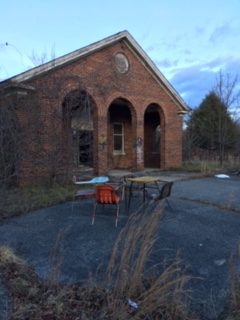The Frightful Forest Haven Asylum

January 9, 2017
Imagine walking down the halls of a hospital and all you see are depressed, sick, and hopeless faces staring back at you. This is exactly what the Forest Haven Mental Institution consisted of when it was operational.
A website called Sometimes Interesting, which uncovers and investigates abandoned places, claims that the facility was originally named District Training School for the Mentally Retarded when it first opened in 1925. It included 22 beautiful buildings spread over 250 acres in a forested area of Laurel, Maryland.
The facility was later renamed “Forest Haven” in order to provoke a peaceful setting for the patients living there. Many of the buildings were referred to as “cottages” and most were given names such as Dogwood, Elm, Hawthorne, Hemlock, Holly, Magnolia, Maple, Oak, Pine, Poplar, and Spruce.
The property also featured a theater, gym, several basketball courts, a baseball field, a cafeteria, and a recreation center. While Forest Haven looked nice and welcoming from the outside, the inside held horrors and nightmares that most people would not believe. The facility contained dental examination rooms, doctors offices, and x-ray rooms, but it also held rooms for electroshock, hydrotherapy, and post-dosage observation.
Many of the patients who lived at Forest Haven had some sort of mental illness, according to Atlas Obscura, a website dedicated to bringing Urbex, or urban exploration, into the light. Some of the disorders included anxiety and panic disorders, bipolar disorder, or schizophrenia. But it was the other types of patients who lived there which made Forest Haven so horrible. By the 1960’s political attitudes towards mental institutions had changed for the worse. As a result of these new attitudes, hundreds of people with treatable learning disabilities were lazily categorized as “retards”and sent to Forest Haven, reports Sometimes Interesting, a site that takes a closer look at captivating forgotten places. Some of the worst cases featured those patients who were not mentally retarded at all. The deaf, dyslexic, illiterate, epileptic, and non-native speakers were just some of the those misunderstood by society or just too much for their families to handle.
An instance of this happened in 1974, when a nearby orphanage closed, and twenty orphans were relocated to Forest Haven. Rather than finding another orphanage for them to reside at, the children were re-classified from “orphan” to “retarded” reports The DCist.
Sometimes Interesting also found that money was a major reason why Forest Haven had a terrible reputation. One case revealed that Forest Haven was spending only $18 per day per patient, while the national average cost per patient per day at the time was just over $30. This lower budget resulted in a lower quality of care to district patients, hurting them instead of helping them.
Looking even further into the issue, Sometimes Interesting found that Forest Haven director R. Rimsky Atkinson said at least 50 of the asylum’s school-age children who had lesser learning disabilities could have lived at home, but did not because city schools lacked adequate educational programs for them.
While many people realized the atrocities that took place at Forest Haven, still nothing was done about them. The DCist writes that when former D.C. mayor Vincent Gray visited Forest Haven as a psychology student in the late 1960s, he called his experience “horrifying” and “the most dehumanizing thing I had ever seen.”
Some of these horrifying things included electroshock therapy, lobotomies, over-crowdedness, and aspiration pneumonia, which is an infection of the lungs caused by patients often being fed laying down. Court orders were filed by the Department of Health demanding that Forest Haven improves its conditions, but they were never enforced.
“Workers here – because of frustration and lack of help – tend to abuse residents,” the asylum’s director told The Washington Post in the mid-seventies. “Of all of our residents, I’d add, some 400 don’t belong here. In many incidents, the facility is contributing to the handicap of retardation.”
Over 387 deaths occurred at Forest Haven, which means it had a residential death rate of twelve percent, and that is using only the reported figures.
This horrifyingly high death rate continued even into the nineties, with ten deaths occurring between 1990 and 1991. While this period was not the most deadly one in the institution’s history, it was the highest death rate, considering the institution had just 252 residents at the time.
Funerals at Forest Haven were uncommon, mostly because these people were already forgotten by society. The institution buried its dead, usually without ceremony, in a field next to the main administration building. The graves were unmarked because high cost prevented them from receiving proper headstones.
The horrendous Forest Haven survived until the very end. Yet in its last three years, the death toll continued to climb, with dozens of residents dying of aspiration pneumonia and other terrible sicknesses.
In late September 1991, the last fifteen residents of Forest Haven were moved out, and the institution officially closed on October 14th. It had served the District for almost 66 years.
Today, the Forest Haven Asylum sits abandoned in Laurel, Maryland, just off route 198. It is regularly patrolled by a team of security guards, hoping to keep out the homeless and vandals. Sadly, this has not worked to its full potential, as the buildings have rapidly deteriorated since its closure. The District made attempts to clean up the facility, but old medical equipment, medical documents, and harmful asbestos can still be found there, reminding us of its haunting past. While the walls of Forest Haven will someday crumble away, the nightmares and horrors that were experienced there will forever remain.















































Amanda Hayes • Apr 28, 2020 at 12:55 PM
It was and still is the most unsettling thing to hire folk that weren’t capable of feeling for the not so bright children that God placed in their hands to love, care and NOT mistreat.